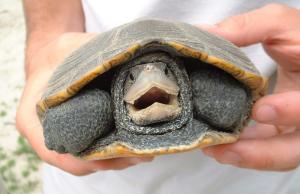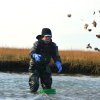Just as summer gets underway and traffic streams down Coastal Highway through Dewey to Bethany and Fenwick, the first female diamondback terrapins are crossing Route 1 to lay their eggs in the soft sand of the ocean dunes.
|
Read Cape Gazette's Visitors' Guide to |
||||
“This morning, a terrapin was on the shoulder of the southbound lane, just north the Indian River Inlet bridge. Fortunately, she paused there long enough for me to pull over, run back and pick her up,” said Sally Boswell, education and outreach coordinator for the Center for the Inland Bays. “This is the second one I’ve rescued off the shoulder this week and put in a sandy area behind the terrapin fencing.” Terrapins are gentle animals; they don't bite and are safe to handle.
From now until early July, female terrapins will leave the coastal marshes and bays to go to the higher, sandy ground of the Atlantic dunes to lay their eggs. Female terrapins are killed each year attempting to cross Route 1 in Delaware Seashore State Park, one of the state’s prime nesting areas for this species.
This mortality impacts heavily on the overall terrapin population because female terrapins mature late and have a long reproductive lifespan, so the loss of a single female represents the loss of many years of potential offspring.
Terrapin mortality is down in the past few years since the Department of Natural Resources and Environmental Control installed fencing along Route 1 to prevent terrapins from crossing the roadway, but some terrapins find their way through or around the barrier. The diamondback terrapin is listed as a species of concern in Delaware and several other states.
Much of the natural shoreline around the Inland Bays is excellent terrapin habitat because of the alternating areas of sandy beaches used for nesting and salt marsh areas necessary for juvenile feeding and growth. But there is a lot of competition for these areas. Shoreline stabilization with bulkheads or riprap threatens terrapin populations. It destroys the narrow strip that has suitable sandy material required for nesting and the high beach elevations necessary for the successful development of terrapin eggs. Research indicates that more than 95 percent of breeding females return to a particular area to nest year after year.
To learn more about helping terrapins, go to www.inlandbays.org/diamondback-terrapin.
For more information go to www.inlandbays.org.
























































